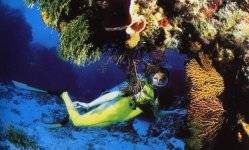TO CUBA
WITH
USA CUBA

|
TO CUBA WITH USA CUBA |
 |
| Welcome
About us Travel tips SPECIALTIES
BUSINESS
PRODUCTS
FEEDBACK
ABOUT CUBA
TRAVEL INDUSTRY
NOTICE
FOR
|
 Holguin
- Guardalavaca Holguin
- Guardalavaca
Regions of Cuba - Travel Guide Located in the eastern part of the country, Holguín stretches for 9,300 square kilometers and is home to 1.5 million inhabitants. The area offers great potential for the development of tourism and recreation. On October 27, 1492, Christopher Columbus landed in Bariay, on the coast of Holguín and immediately said that it was the most beautiful land ever seen by human eyes. Numerous aboriginal settlements were part of the landscape in those distant times. The trade winds blow almost all year round, creating the special conditions for a pleasant temperate climate in an extraordinary setting where the unpolluted waters of the Atlantic Ocean bathe 22 coastal bays. Potential tourist attractions include 34 rivers, six waterfalls—among them Guayabo, the largest in the country—and six dams, as well as five submarine areas, nineteen historical and cultural sites, 135 archaeological sites and about 60 kilometers of beaches composed of exquisite white sand.
The highest achievement of its tourist infrastructure lies in its being one with nature, blending harmoniously with the sea and the forest . Nevertheless, the essential facilities and services capable of meeting the requirements of modern life are still very much available. Guardalavaca, one of the most famous beaches in the province, offers tourists luxuriant coral reefs, interesting cliffs and amazing vegetation. Guardalavaca covers a 1,200 metre-long bank formed by shell-like beaches, creating intimate surroundings that are frequently enhanced by enormous cliffs. Guardalavaca is not far from Gibara, the place where Colón first landed in Cuba. Boca de las Esponjas, El Salto and Cañon de los Aguajíes are only a few of the best-known sites, all of them ideal for scuba diving, while Tanques Azules, in neigbouring Gibara, a grouping of unique flooded caverns, offer special challenges for speleodivers. 65 kilometers from Frank Pais International Airport, the City of Holguín is also very close to other colorful sites, such as Banes and Gibara, the latter being the only Cuban city besides Havana to be surrounded by walls.
Among other attractions,
Holguín
offers the Loma de la Cruz (the Hill of the Cross), the most famous
place in the city, featuring a 450-step stairway that is replete with legends.
The site was founded on May 3, 1950, and every anniversary is celebrated
with a pilgrimage, masses and a multitude of dances.
Updated August
20, 2000
Copyright ©2000 USA CUBA TRAVEL |